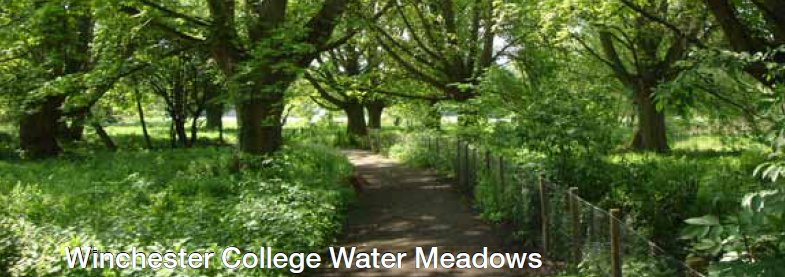Winchester College Water Gardens - TrustNews Jun 12

When I was a boy in the College the water meadows north of Garnier Road were grazed by cattle belonging to Mr Corbett, who had a dairy at Wharf Farm. With his retirement in the 1960s the reed beds ceased to be burnt in the autumn and the landscaping scheme, designed by the college Art Master at the time, included a plantation of Brazilian wingnut trees. The Fallowden meadows lost the qualities for which they were given Site of Special Site of Interest (SSSI) status and became a nature reserve – now subject to the study of botany and zoology rather than farming.
Since my return in the 1980s to manage the College Estates I have long wanted to graze the meadows again and return them to “favourable” SSSI condition. However, as we are a charity, I have been unable to justify the cost of well over £50,000. Two recent events have changed that.
The first was the preparation of the Winchester College Development Plan in 2009 which included the restoration of the meadows as a planning objective. After much consultation and public meetings the Plan was adopted despite scaremongering that 2000 trees were to be felled. The actual number is 28 Brazilian wingnuts, half a dozen non-native species and some of the dead, dying and dangerous trees. An avenue of willows will be planted along Brandy Stream to replace the wingnuts and give shade to spawning salmon.
The second event was the acceptance of the area by Natural England (NE) for Higher Level Stewardship, with the objective of returning cattle to the meadows after fencing, felling and opening the meadow to the Itchen Navigation Canal for the cattle to drink. All the river carriers, which have Special Area of Conservation Status, will be protected. They are the most researched salmon spawning grounds by the Environment, Fisheries and Agriculture Science (Cefas). The existing permitted access will be maintained with the use of kissing gates.
After protracted consultations with NE, Cefas, the Environment Agency and Hampshire Wildlife Trust, all stakeholders were agreed on the principle and methodology of felling, fencing and grazing. It takes several years to try to satisfy the needs of fishermen, scientists, conservationists, government and locals who simply want to enjoy a walk.
The total area of about 17 hectares will be restored in two phases with the first fencing starting between Garnier Road and Brandy Stream this spring, cattle grazing from May, tree felling in the autumn and phase 2 north of Brandy Stream in 2013.
